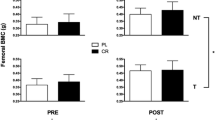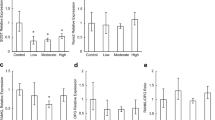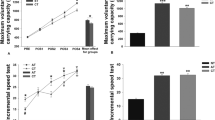Abstract
The role of exercise in promoting bone health is typically attributed to increased mechanical loading, which induces functional adaptation. Recent evidence suggests that habitual aerobic exercise has influence at the cellular level as well. The effect of aerobic capacity on osteoblast-lineage cell differentiation and function as well as skeletal phenotype is unknown. Using a rat model of high-capacity and low-capacity runners (HCRs and LCRs, respectively), in which an intrinsic functional genomic difference in aerobic capacity exists between nontrained animals, this study evaluated the effects of aerobic capacity on measures of bone mass and strength as well as osteoblast activity following ovariectomy. The ovariectomized rat emulates the clinical features of the estrogen-depleted human skeleton and represents a valuable model for studying short-term upregulation of osteoblast activity. We hypothesized that intrinsically high aerobic capacity would augment osteoblast response, which would mitigate the deleterious effects of hormone withdrawal. Femora and tibiae were assessed by micro-computed tomography, mechanical testing, and dynamic histomorphometry. HCRs had enhanced femoral tissue mineral density and estimated elastic modulus relative to LCRs. At 4 weeks postovariectomy, HCRs demonstrated a more robust osteoblast response. Markers of bone formation were upregulated to a greater extent in HCRs than LCRs, suggesting a role for aerobic capacity in governing osteoblast activity. Results from this and future studies will help to identify the influence of cellular aerobic metabolism on bone health, which may lead to new strategies for targeting diseases of the skeleton.




Similar content being viewed by others
References
Davies KJ, Packer L, Brooks GA (1981) Biochemical adaptation of mitochondria, muscle, and whole-animal respiration to endurance training. Arch Biochem Biophys 209:539–554
Navarro A, Gomez C, Lopez-Cepero JM, Boveris A (2004) Beneficial effects of moderate exercise on mice aging: survival, behavior, oxidative stress, and mitochondrial electron transfer. Am J Physiol Regul Integr Comp Physiol 286:R505–R511
Boveris A, Navarro A (2008) Systemic and mitochondrial adaptive responses to moderate exercise in rodents. Free Radic Biol Med 44:224–229
Koch LG, Britton SL (2001) Artificial selection for intrinsic aerobic endurance running capacity in rats. Physiol Genomics 5:45–52
Wisloff U, Najjar SM, Ellingsen O, Haram PM, Swoap S, Al-Share Q, Fernstrom M, Rezaei K, Lee SJ, Koch LG, Britton SL (2005) Cardiovascular risk factors emerge after artificial selection for low aerobic capacity. Science 307:418–420
Noland RC, Thyfault JP, Henes ST, Whitfield BR, Woodlief TL, Evans JR, Lust JA, Britton SL, Koch LG, Dudek RW, Dohm GL, Cortright RN, Lust RM (2007) Artificial selection for high-capacity endurance running is protective against high-fat diet-induced insulin resistance. Am J Physiol Endocrinol Metab 293:E31–E41
Morris EM, Whaley-Connell AT, Thyfault JP, Britton SL, Koch LG, Wei Y, Ibdah JA, Sowers JR (2009) Low aerobic capacity and high-fat diet contribute to oxidative stress and IRS-1 degradation in the kidney. Am J Nephrol 30:112–119
Hirao M, Hashimoto J, Yamasaki N, Ando W, Tsuboi H, Myoui A, Yoshikawa H (2007) Oxygen tension is an important mediator of the transformation of osteoblasts to osteocytes. J Bone Miner Metab 25:266–276
Zahm AM, Bucaro MA, Srinivas V, Shapiro IM, Adams CS (2008) Oxygen tension regulates preosteocyte maturation and mineralization. Bone 43:25–31
Halonen NR, Cole JH, Goulet GC, Sobel A, Koch LG, Britton SL, Morris MD, Zernicke RF, Kozloff K (2010) Influence of intrinsic and trained aerobic capacity on bone mineralization and material properties. In: Transactions of the 56th Annual Meeting of the Orthopaedic Research Society, New Orleans, LA, 35:0069
Halonen NR, Tayim R, Goulet GC, Cole JH, Clifford C, Goldstein SA, Koch LG, Britton SL, Zernicke RF, Alford AI, Kozloff K (2010) Intrinsic aerobic capacity influences MSC proliferation, mineralization, and fracture healing. In: Transactions of the 56th Annual Meeting of the Orthopaedic Research Society, New Orleans, LA, 35:1712
Jee WS, Yao W (2001) Overview: animal models of osteopenia and osteoporosis. J Musculoskelet Neuronal Interact 1:193–207
Bagi CM, DeLeon E, Ammann P, Rizzoli R, Miller SC (1996) Histo-anatomy of the proximal femur in rats: impact of ovariectomy on bone mass, structure, and stiffness. Anat Rec 245:633–644
Sato M, Zeng GQ, Turner CH (1997) Biosynthetic human parathyroid hormone (1–34) effects on bone quality in aged ovariectomized rats. Endocrinology 138:4330–4337
Turner CH, Burr DB (1993) Basic biomechanical measurements of bone: a tutorial. Bone 14:595–608
Taylor DK, Meganck JA, Terkhorn S, Rajani R, Naik A, O’Keefe RJ, Goldstein SA, Hankenson KD (2009) Thrombospondin-2 influences the proportion of cartilage and bone during fracture healing. J Bone Miner Res 24:1043–1054
Hou JC, Zernicke RF, Barnard RJ (1990) High fat–sucrose diet effects on femoral neck geometry and biomechanics. Clin Biomech (Bristol, Avon) 5:162–168
Manske SL, Steiner D, Kim SH, Boyd SK, Koch LG, Britton SL, Hepple RT, Zernicke RF (2008) Differences in bone morphology in older female rats selectively bred for high and low aerobic capacity. In: Transactions of the 54th Annual Meeting of the Orthopaedic Research Society, San Francisco, CA, 33:0910
Myers J, Prakash M, Froelicher V, Do D, Partington S, Atwood JE (2002) Exercise capacity and mortality among men referred for exercise testing. N Engl J Med 346:793–801
Kalu DN (1991) The ovariectomized rat model of postmenopausal bone loss. Bone Miner 15:175–191
Wronski TJ, Cintron M, Dann LM (1988) Temporal relationship between bone loss and increased bone turnover in ovariectomized rats. Calcif Tissue Int 43:179–183
Wronski TJ, Dann LM, Scott KS, Cintron M (1989) Long-term effects of ovariectomy and aging on the rat skeleton. Calcif Tissue Int 45:360–366
Lelovas PP, Xanthos TT, Thoma SE, Lyritis GP, Dontas IA (2008) The laboratory rat as an animal model for osteoporosis research. Comp Med 58:424–430
Danielsen CC, Mosekilde L, Svenstrup B (1993) Cortical bone mass, composition, and mechanical properties in female rats in relation to age, long-term ovariectomy, and estrogen substitution. Calcif Tissue Int 52:26–33
Mosekilde L, Sogaard CH, Danielsen CC, Torring O (1991) The anabolic effects of human parathyroid hormone (hPTH) on rat vertebral body mass are also reflected in the quality of bone, assessed by biomechanical testing: a comparison study between hPTH-(1–34) and hPTH-(1–84). Endocrinology 129:421–428
Aerssens J, van Audekercke R, Talalaj M, Geusens P, Bramm E, Dequeker J (1996) Effect of 1alpha-vitamin D3 and estrogen therapy on cortical bone mechanical properties in the ovariectomized rat model. Endocrinology 137:1358–1364
Hou JC, Zernicke RF, Barnard RJ (1991) Experimental diabetes, insulin treatment, and femoral neck morphology and biomechanics in rats. Clin Orthop Relat Res 264:278–285
Nakamura Y, Naito M, Hayashi K, Fotovati A, Abu-Ali S (2008) Effect of combined treatment with alendronate and calcitriol on femoral neck strength in osteopenic rats. J Orthop Surg Res 3:51
Sharkey NA, Lang DH, Okita N, Koch LG, Britton SL (2006) Differences in bone morphology in older female rats selectively bred for high and low aerobic capacity. In: Transactions of the 52nd Annual Meeting of the Orthopaedic Research Society. Chicago, IL, p 348
Oxlund BS, Ortoft G, Andreassen TT, Oxlund H (2003) Low-intensity, high-frequency vibration appears to prevent the decrease in strength of the femur and tibia associated with ovariectomy of adult rats. Bone 32:69–77
Yao W, Hadi T, Jiang Y, Lotz J, Wronski TJ, Lane NE (2005) Basic fibroblast growth factor improves trabecular bone connectivity and bone strength in the lumbar vertebral body of osteopenic rats. Osteoporos Int 16:1939–1947
Andresen CJ, Moalli M, Turner CH, Berryman E, Pero R, Bagi CM (2008) Bone parameters are improved with intermittent dosing of vitamin D3 and calcitonin. Calcif Tissue Int 83:393–403
Halonen NR, Tayim R, Goulet GC, Cole JH, Clifford C, Goldstein SA, Koch LG, Britton SL, Zernicke RF, Alford AI, Kozloff K (2010) Intrinsic aerobic capacity influences MSC proliferation, mineralization, and fracture healing. In: Transactions of the 56th Annual Meeting of the Orthopaedic Research Society, New Orleans, LA, 35:1712
Frost HM (1997) Obesity, and bone strength and “mass”: a tutorial based on insights from a new paradigm. Bone 21:211–214
Novak CM, Escande C, Gerber SM, Chini EN, Zhang M, Britton SL, Koch LG, Levine JA (2009) Endurance capacity, not body size, determines physical activity levels: role of skeletal muscle PEPCK. PLoS One 4:e5869
Tou JC, Foley A, Yuan YV, Arnaud S, Wade CE, Brown M (2008) The effect of OVX combined with hindlimb unloading and reloading on the long bones of mature Sprague-Dawley rats. Menopause 15:494–502
Acknowledgments
We are grateful to K. Sweet, B. Nolan, C. Roehm, D. Kayner, and C. Clifford for their contributions to this work. We thank the National Institutes of Health (grant R24 RR17718 to S. L. B. and L. G. K.) for partial funding support.
Author information
Authors and Affiliations
Corresponding author
Additional information
The authors have stated that they have no conflict of interest.
Rights and permissions
About this article
Cite this article
Goulet, G.C., Halonen, N.R., Koch, L.G. et al. Osteoblast Response to Ovariectomy Is Enhanced in Intrinsically High Aerobic-Capacity Rats. Calcif Tissue Int 88, 325–335 (2011). https://doi.org/10.1007/s00223-010-9457-x
Received:
Accepted:
Published:
Issue Date:
DOI: https://doi.org/10.1007/s00223-010-9457-x




